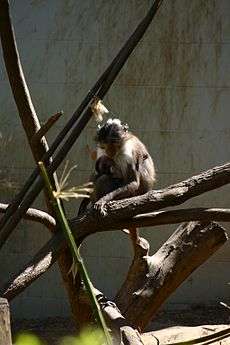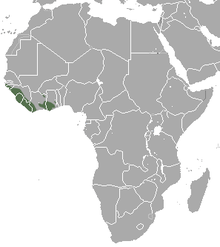Sooty mangabey
| Sooty mangabey [1] | |
|---|---|
 | |
| White-collared Mangabey (C. atys lunulatus) | |
| Scientific classification | |
| Kingdom: | Animalia |
| Phylum: | Chordata |
| Class: | Mammalia |
| Order: | Primates |
| Family: | Cercopithecidae |
| Genus: | Cercocebus |
| Species: | C. atys |
| Binomial name | |
| Cercocebus atys (Audebert, 1797) | |
 | |
| Sooty Mangabey range | |
The sooty mangabey (Cercocebus atys) is an Old World monkey found in forests from Senegal in a margin along the coast down to Ghana.[1] While overall rated as Near Threatened, the eastern race lunulatus, also known as the white-crowned,[3] white-naped[4] or white-collared mangabey (leading to confusion with the collared mangabey), is considered Endangered by the IUCN.[5] The White-collared mangabey was declared its own species by the IUCN in 2016, but it retains the endangered conservation status.[2]
Habitat and ecology
The sooty mangabey is native to tropical West Africa, being found in Guinea, Guinea-Bissau, Liberia, Senegal, Sierra Leone and Ivory Coast.[2] It lives in both old growth and secondary forests as well as in flooded, dry, swamp, mangrove, and gallery forests. The primate is arboreal and diurnal. They are omnivores whose diet includes primarily fruits and seeds, sometimes feeding on small animals. They live in social groups of four to twelve individuals, but occasionally groups as large as 95 individuals have been recorded.[6]
Taxonomy
There are two distinctive subspecies of this mangabey, and it is possible they should be considered separate species. Both were formerly considered subspecies of a widespread Cercocebus torquatus.[1]
- Cercocebus atys atys (west of the Sassandra River)
- White-collared (or White-crowned) mangabey, Cercocebus atys lunulatus (east of the Sassandra River).
Disease
Sooty mangabeys are naturally infected with a strain of Simian Immunodeficiency Virus (SIV), known as SIVsmm. Due to extensive human-mangabey contact in sub-Saharan Africa, SIVsmm has jumped from this species into humans on multiple occasions, resulting in HIV-2 virus. The HIV-1 strain by contrast came from the common chimpanzee strain of SIV.[7][8]
The sooty mangabey can also contract leprosy, as can humans, the nine-banded armadillo, the common chimpanzee, and the crab-eating macaque.[9]
Status
The sooty mangabey is believed to be decreasing in numbers as its forest habitat is degraded, with trees being felled for firewood and timber, and it is hunted for food in some parts of its range. It is more terrestrial than some of its relatives and sometimes raids farms, which brings it into conflict with humans. The International Union for Conservation of Nature has assessed its conservation status as "near-threatened".[2]
References
- 1 2 3 Groves, C.P. (2005). Wilson, D.E.; Reeder, D.M., eds. Mammal Species of the World: A Taxonomic and Geographic Reference (3rd ed.). Baltimore: Johns Hopkins University Press. p. 153. OCLC 62265494. ISBN 0-801-88221-4.
- 1 2 3 4 Oates, J. F.; Gippoliti, S. & Groves, C. P. (2016). "Cercocebus atys". IUCN Red List of Threatened Species. Version 2016.2. International Union for Conservation of Nature. Retrieved 22 July 2016.
- ↑ White-crowned Mangabey. Mangabey Species Survival Plan. Accessed 2008-07-18
- ↑ http://www.primate-sg.org/lunulatus.htm White-Naped Mangabey Cercocebus atys lunulatus. Accessed 2011-11-03
- ↑ Oates, J. F.; Gippoliti, S. & Groves, C. P. (2008). "Cercocebus atys ssp. lunulatus". IUCN Red List of Threatened Species. Version 2008. International Union for Conservation of Nature. Retrieved 4 January 2009.
- ↑ Rowe, N. (1996). The Pictorial Guide to the Living Primates. East Hampton, New York: Pogonias Press.
- ↑ Binhua Ling; Cristian Apetrei; Ivona Pandrea; Ronald S. Veazey; Andrew A. Lackner; Bobby Gormus & Preston A. Marx (August 2004). "Classic AIDS in a Sooty Mangabey after an 18-Year Natural Infection". J. Virol. 78 (16): 8902–8908. doi:10.1128/JVI.78.16.8902-8908.2004. PMC 479084
 . PMID 15280498.
. PMID 15280498. - ↑ Lemey, P.; Pybus, O. G.; Wang, B.; Saksena, N. K.; Salemi, M.; Vandamme, A. M. (2003). "Tracing the origin and history of the HIV-2 epidemic". Proceedings of the National Academy of Sciences. 100 (11): 6588–6592. doi:10.1073/pnas.0936469100. PMC 164491
 . PMID 12743376.
. PMID 12743376. - ↑ Rojas-Espinosa O, Løvik M (2001). "Mycobacterium leprae and Mycobacterium lepraemurium infections in domestic and wild animals". Rev. Sci. Tech. Off. Int. Epiz. 20 (1): 219–51. PMID 11288514.
External links
- Sooty Mangabey
- Photos and information about the Sooty Mangabey (Cercocebus atys). ARKive.
- Primate Info Net Cercocebus atys Factsheet
| Wikispecies has information related to: Sooty Mangabey |
